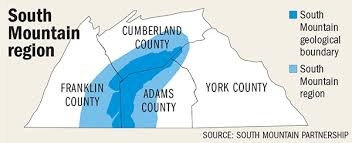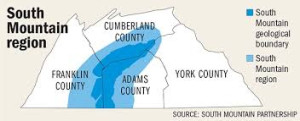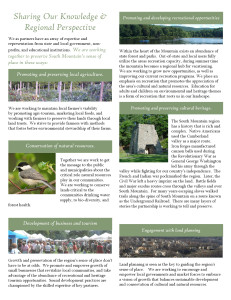What should you do for something you enjoy having in your life –a favorite building, deli, museum, music collection, antique, pet, or person? You ensure its survival by providing healthy surroundings. What if your labor to support and protect what you hold dear is eased by others who feel the same? Many hands make light work. What if that shared labor meant coordinating over fifty organizations composed of non-profits, businesses, and local, state, and federal partners? Things would get a bit complex. This is both the opportunity and the challenge of collaboratively managing – involving multiple stakeholder groups along with conventional managers, researchers, and specialists – in managing historic resources.
Although historic preservation may not be the main goal of a collaboratively managed preservation group, historic preservation still benefits because such a group brings together diverse groups of people committed to sharing resources in order to reach a common goal. Historic preservation is usually represented within this diverse group. Organizations that use collaborative management to define goals and strategies, such as the South Mountain Partnership (SMP), are also a hub of resources and activities supporting stakeholder goals. Promising “to sustain the South Mountain Region’s quality of life which is critically reliant on its natural, cultural, and economic assets,” SMP is a Conservation Landscape Initiative co-led by Pennsylvania Department of Conservation and Natural Resources and the Appalachian Trail Conservancy.
SMP’s goals are similar to many preservation organizations in that it initiates and encourages action for many types of preservation: promote and preserve local agriculture and cultural heritage, conserve natural resources, develop business and tourism, promote and develop recreational opportunities, and engage land planning. SMP is the entity that administers collaborative management strategies to welcome the participation of over fifty non-profits, businesses, and government offices and agencies. Begun in 2006, it acknowledged the power of partnership to conserve sense of place.
Although originally formed to preserve the Glatfelter Tree Farm in Adams County and White Rocks in Cumberland County, the partnership expanded its goals to include education and grant funding. Historic preservation within the region has benefited. The Partnership held an Appalachian Trail Community Forum in 2009 and a Regional Trail Summit in 2010. Its Speaker’s Series included Restoration of the American Chestnut, The Union of Historic Farms and Food, and Preservation of Our Heritage and History. Camp Michaux, one of only a few World War II interrogation camps, was preserved through SMP efforts. Historically, the camp also served as an iron ore era farm, a Civilian Conservation Camp, and a church camp. In addition, historic interpretative signs in Boiling Springs and preservation of the Battle of Monterey Pass site were realized through SMP efforts. Using a partnership approach, SMP has accomplished so much.
I first learned of collaborative management while conducting land use and water quality research; and did not fully understand why my professor insisted I include an aspect of community participation in my project. The professor’s reason for including the community in my research effort is this: power sharing – every person has a right to influence how their homeland is or is not managed – social capacity building – when people open-up and share personal visions for their homeland, connections develop between people, businesses, and organizations. These connections are far more meaningful and longer-lasting than those developed through simple networking – and learning – over one year, inclusive data collection, like workshops and break-out sessions, develop more cooperation and knowledge about the issue than years of static, outdated management approaches. This learning lets you refine strategies and react more quickly, maintaining momentum and losing fewer individuals or groups to frustration. The professor knew that a successful long-term research program requires building long-term stakeholder cooperation; much like SMP continues to develop and support stakeholders.
Collaborative management can benefit historic preservation projects and initiatives in Pennsylvania, as seen through the results achieved by SMP members, organizers, and cooperators. It is a modern trend in many parts of Pennsylvania and began as a response to static, inflexible management plans. More recently, it spread to preservation initiatives as a response to limited funding and resources. The South Mountain Partnership is an example of how collaborative management can assist in accomplishing diverse goals that include historic preservation.
Monroe, M. C., R. Plate, and A. Oxarart. 2013. Intermediate collaborative adaptive management strategies build stakeholder capacity. Ecology and Society 18(2): 24.
“South Mountain Partnership,” accessed September 13, 2013, http://www.southmountain partnership.org/.
Comment Policy
PHMC welcomes and encourages topic-related comments on this blog. PHMC reserves the right to remove comments that in PHMC’s discretion do not follow participation guidelines.
Commenters and Comments shall be related to the blog post topic and respectful of others who use this site.
Commenters and Comments shall not: use language that is offensive, inflammatory or provocative (this includes, but is not limited to, using profanity, obscene, or vulgar comments); disparage other commenters or people; condone illegal activity; identify the location of known or suspected archeological sites; post personal information in comments such as addresses, phone numbers, e-mail addresses or other contact details, which may relate to you or other individuals; impersonate or falsely claim to represent a person or an organization; make any commercial endorsement or promotion of any product, service or publication.
If you would like to comment on other topics not related to this blog post but related to PHMC, please fill out the PHMC Contact Us Form.



Leave a Reply